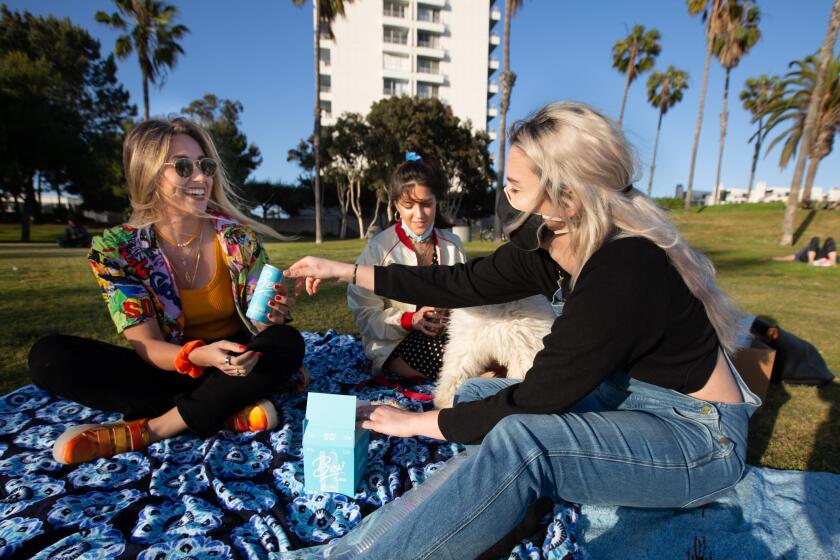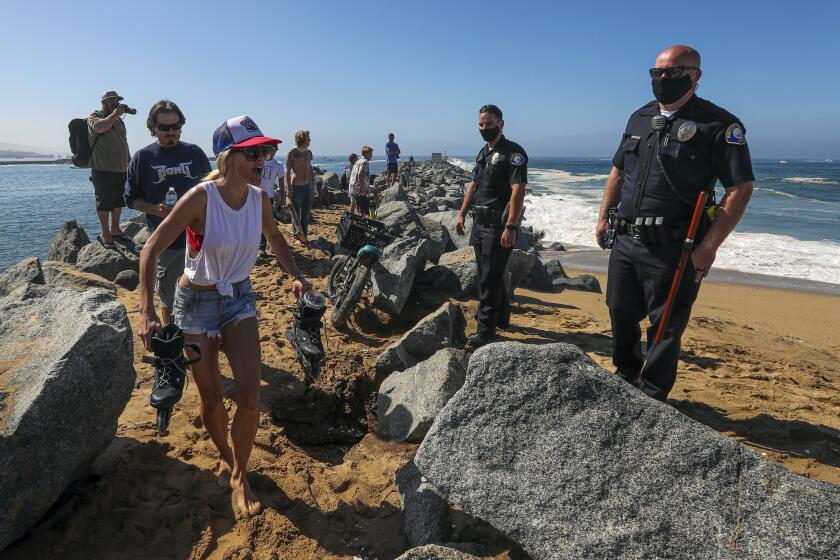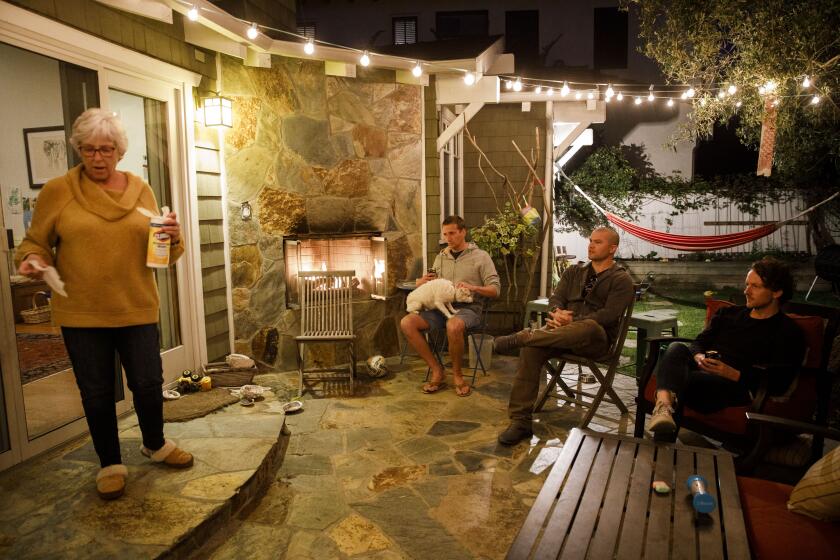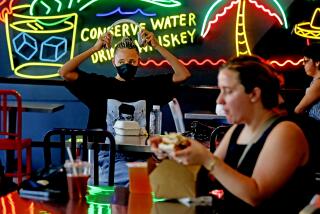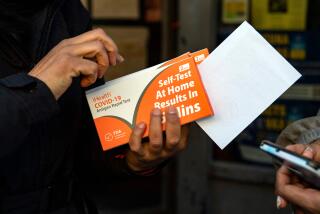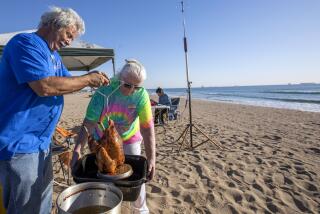Can I see my friends yet? What the current coronavirus guidance says
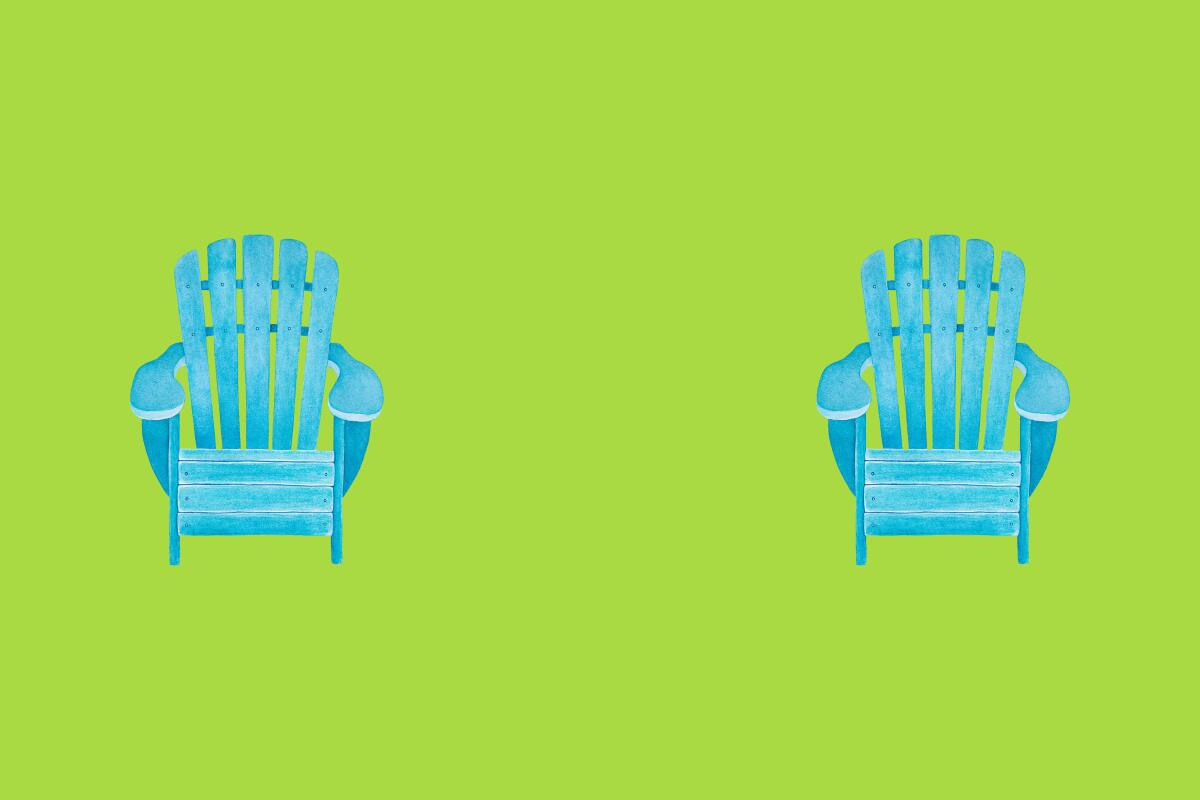
- Share via
Slowly but surely, the restrictions are lifting. More stores are open for pickup. Beaches and hiking trails are welcoming active sun-seekers again, though not loungers. (Also, good luck finding a parking spot.)
This flurry of economic activity has a lot of people wondering: Does that mean I can hang out with my friends?
The short answer is no, not right now. Just because you can go to the beach again does not mean you can go and share a blanket with your friends just yet.
But it’s not a silly question. While getting together with friends and family is perhaps not as critical to survival as shelter and food and a way to pay for those things, socialization is an essential part of our well-being. Isolation is lonely, particularly if you’re quarantining by yourself. And the long days and warm weather are just calling out for summer fun. Quarantine fatigue is a thing; it’s normal to be chafing at all the new rules and craving social interaction right now.
California and Los Angeles both have websites dedicated to COVID-19 resources that address essential services, businesses, schools and childcare, but it’s hard to find specific information on when we might be able to get together in small groups at people’s homes again. (Queries to both the state and city departments of public health for specific information on social gatherings were not returned.)
Coronavirus: Some Angelenos loosen up their personal boundaries as they try to balance safety and mental health
A lot of our actions now and in the near future will need to be guided by common sense — something that admittedly can feel in short supply. There are ways to socialize that respect our human need to spend time with our loved ones while reducing the potential risk as much as possible. They just require some forethought and nuance.
Here’s how you can see other people safely right now, what you can expect as restrictions ease, and how to assess the potential risk to yourself, the people you live with and the people you want to see.
What you can do now
As long as you practice physical distancing precautions, you can see your friends. Your faces must stay covered and you have to keep a minimum of six feet between you. Ideally, you should be outdoors, where there’s better ventilation and the virus is less space-constrained.
The main thing is that you have to agree to follow those rules and best practices to minimize the risk. Something like putting sanitized lawn chairs at a minimum of six feet apart on your front lawn or going for a walk while wearing face coverings and maintaining that personal space bubble could be acceptable if — big if — all involved are willing to strictly obey all social distancing and hygiene guidelines, said Paula Cannon, a virologist and professor of molecular microbiology and immunology at the Keck School of Medicine at USC.
Keep in mind that the six-foot rule is the minimum, not the maximum, she said. If you can do 10 or 15 feet apart, that’s better than six, particularly if you’re engaging in an exerting activity or speaking loudly. The more and harder you exhale, the more droplets you’re expelling.
It helps to frame it in “a way that becomes an act of love instead of an act of deprivation,” she said. You’re not doing these things to deprive yourself of normal interaction. You’re doing this to express that you care about the other person enough to keep them as safe as possible.
And despite how much you love them, you can’t violate that six-foot boundary at all, even briefly. Sorry: No hugs.
Hugging “really violates the whole concept of social distancing,” said Dr. David Reuben, the chief of the division of geriatrics at the David Geffen School of Medicine at UCLA. “There’s a time for every purpose under heaven and it’s not the time for hugs.”
What to expect in the near future
As social distancing restrictions begin to ease in the coming weeks and months, smaller gatherings will be considered safe again. But it’s not a switch that’s going to flip from “wear masks and stay six feet apart at all times” to “throw a raging house party and invite everyone you’ve ever met.”
Every expert interviewed for this article said the parties of the near future will probably involve fewer than 10 people total, should be outdoors or as close to it as possible, and you should still expect to be practicing good hygiene and touching shared surfaces and each other as little as possible.
So that rager, no. But how about a backyard barbecue with a small group of friends where you make sure not to share utensils, people wear face coverings when they’re not eating, everyone washes their hands a lot, the seating is spaced out, and no one crowds around the grill except the chef? We could see things like that being OKd by as early as the end of June, said Robert Kim-Farley, a professor-in-residence at the UCLA Fielding School of Public Health and an infectious disease expert and former senior official with the Los Angeles County Department of Public Health, the Centers for Disease Control and Prevention, and the World Health Organization. Hugs and handshakes will still not be advised.
Los Angeles County’s stay-at-home orders will ‘with all certainty’ be extended for the next three months, Public Health Director Barbara Ferrer said.
And yes, if you’ve got a pool, you could use it: Chlorine kills the virus. Keep in mind, though, that you’re still at risk from other people’s exhalations, as well as from shared surfaces like the pool ladder.
Everyone will need to take proper precautions before getting together. Guests who don’t feel well in any way — even if it’s the sort of mild sniffles you might ordinarily power through with some over-the-counter allergy meds — should stay home. Having everyone take their temperature before they come over isn’t the worst idea in the world, though it isn’t foolproof; you can have the virus and not have a fever. No single precaution will 100% prevent you from catching the coronavirus, but the more layers of protection you add, the lower the risk becomes, experts say.
Think of how many safety features your car has: Seat belts, airbags, bumpers, anti-lock brakes, backup cameras, an alert when you’re drifting out of your lane. None of those things will singularly prevent all car accidents or injuries, but used in conjunction they minimize your risk. That’s what you’re doing when you wash your hands frequently, wear your mask, stay six feet away from others, and monitor your symptoms and avoid leaving the house when you don’t feel well.
Assessing your risk
Before you decide to socialize, you need to assess the risk to yourself, the people you’re quarantining with and the people you plan to see. There is no one-size-fits-all recommendation.
“We’re all going to have to be looking at the spectrum of risk and reward from an individual level to ultimately a societal level,” Kim-Farley said.
If you are in a high-risk group for adverse effects from the coronavirus, you should keep that in mind when you’re deciding whether to RSVP to a pool party. Similarly, if you’re healthy and at low risk but live with someone who isn’t, it might be better to put off getting together until more time has passed. And while many of us wish we could be with our older relatives now more than ever, you can pass the virus to them without ever realizing you were contagious. Err on the side of caution whenever possible.
Another thing to keep in mind, he said: “The road to recovery won’t necessarily be a straight line. At some point, if cases of the virus start to increase too quickly, we might revert back to a previous stage of the road map, which could include having to cancel your party plans.”
You’ve stayed at home long enough and want to socialize with your friends. Here’s how you can gather without putting your health -- or theirs -- in jeopardy.
Kim-Farley also pointed out that we won’t necessarily have to wait for a vaccine to feel even semi-normal again. Interventions like remdesivir aren’t a cure for the coronavirus, but if doctors and scientists are able to discover that an existing medication like that improves outcomes for high-risk patients, it could be enough protection to warrant easing restrictions faster. He compared it to how nursing homes often administer Tamiflu proactively to residents in nursing homes that have a single case of the flu to prevent it from spreading. Most experts think we will likely see a vaccine within the next 12-18 months, but could find the coronavirus’ Tamiflu a lot sooner than that.
Ultimately, try to remember this: It won’t be this way forever. All of this is temporary. There will be another summer when you can go to a Dodgers game and the Hollywood Bowl and throw a massive party for the Fourth of July where you pull in every guest for an extended hug. The best way to make that happen as soon as possible is to follow the guidance that’s out there now.
More to Read
Sign up for The Wild
We’ll help you find the best places to hike, bike and run, as well as the perfect silent spots for meditation and yoga.
You may occasionally receive promotional content from the Los Angeles Times.
